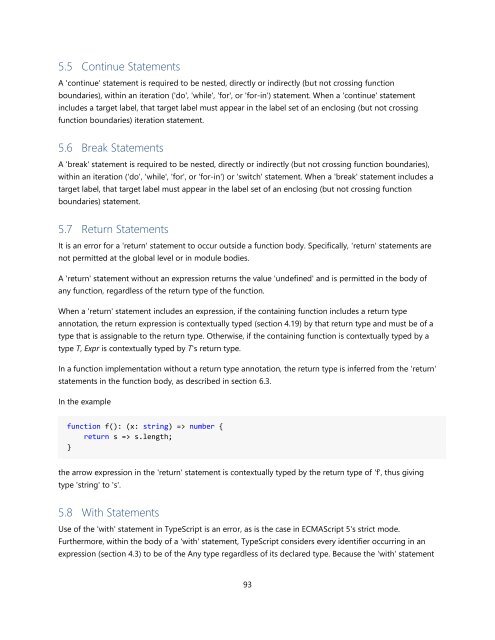TypeScript Language Specification v1.5
TypeScript Language Specification v1.5
TypeScript Language Specification v1.5
You also want an ePaper? Increase the reach of your titles
YUMPU automatically turns print PDFs into web optimized ePapers that Google loves.
5.5 Continue Statements<br />
A 'continue' statement is required to be nested, directly or indirectly (but not crossing function<br />
boundaries), within an iteration ('do', 'while', 'for', or 'for-in') statement. When a 'continue' statement<br />
includes a target label, that target label must appear in the label set of an enclosing (but not crossing<br />
function boundaries) iteration statement.<br />
5.6 Break Statements<br />
A 'break' statement is required to be nested, directly or indirectly (but not crossing function boundaries),<br />
within an iteration ('do', 'while', 'for', or 'for-in') or 'switch' statement. When a 'break' statement includes a<br />
target label, that target label must appear in the label set of an enclosing (but not crossing function<br />
boundaries) statement.<br />
5.7 Return Statements<br />
It is an error for a 'return' statement to occur outside a function body. Specifically, 'return' statements are<br />
not permitted at the global level or in module bodies.<br />
A 'return' statement without an expression returns the value 'undefined' and is permitted in the body of<br />
any function, regardless of the return type of the function.<br />
When a 'return' statement includes an expression, if the containing function includes a return type<br />
annotation, the return expression is contextually typed (section 4.19) by that return type and must be of a<br />
type that is assignable to the return type. Otherwise, if the containing function is contextually typed by a<br />
type T, Expr is contextually typed by T's return type.<br />
In a function implementation without a return type annotation, the return type is inferred from the 'return'<br />
statements in the function body, as described in section 6.3.<br />
In the example<br />
function f(): (x: string) => number {<br />
return s => s.length;<br />
}<br />
the arrow expression in the 'return' statement is contextually typed by the return type of 'f', thus giving<br />
type 'string' to 's'.<br />
5.8 With Statements<br />
Use of the 'with' statement in <strong>TypeScript</strong> is an error, as is the case in ECMAScript 5's strict mode.<br />
Furthermore, within the body of a 'with' statement, <strong>TypeScript</strong> considers every identifier occurring in an<br />
expression (section 4.3) to be of the Any type regardless of its declared type. Because the 'with' statement<br />
93


















